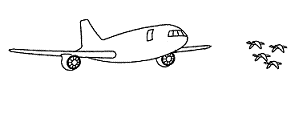Bird Strike Committee Proceedings
Date of this Version
August 2000
Abstract
Conflicts between birds and commercial aircraft are a noteworthy problem at both large and small airports. The risk factor for U.S. airports continues to increase due to the steady rise in take-off/landings and bird populations. The focus of bird strike mitigation in the past has centered primarily on Wildlife Management techniques. Recently, an Avian Hazard Advisory System (AHAS) has been developed to reduce the risks of bird strikes to military operations. This system uses a mosaic of data collected by the Next Generation Weather Radar (NEXRAD). This sensor serves as an excellent tool for enroute bird advisories due to the radar coverage provided across the majority of the U.S. The Federal Aviation Administration (FAA) has deployed a network of Terminal Doppler Weather Radars (TDWR) at major U.S. airports to increase safety and reduce delays. While the primary intent of this system is to detect weather, the operating characteristics allow for the detection of biological echoes as well. In fact, roosting birds are a common component of this radar system during peak activity periods near sunrise and sunset. This sensor provides excellent coverage and update rates within the terminal area for bird detection. Another terminal area detection sensor deployed by the FAA is the Airport Surveillance Radar (ASR-9). While the primary goal of the target channel is aircraft identification, this radar is also able to detect biological echoes near the airport. Proposed enhancements to the ASR-9 will make this sensor more efficient as a weather/bird detection sensor. The high update rate (5 seconds) makes the ASR-9 a highly desirable platform for a bird detection and warning system. In this paper, the bird detection capabilities of the TDWR and ASR-9 target channel will be discussed. Data on bird events from a number of diverse locales will be used to identify a characteristic set of diagnostic variables for roosting birds. The diagnostic variables will serve as the input to a Terminal Avian Hazard Advisory System (TAHAS) based on an interest fusion approach similar to that employed for the Integrated Terminal Weather System (ITWS) gust front detection and microburst prediction algorithms. Data from recent bird strike incidents at ITWS supported airports will serve to refine the diagnostic variables to better detect small numbers of birds during off-peak roosting times. Hopefully, the TAHAS can be operationally evaluated at a major airport such as John F. Kennedy (JFK), which is situated in an area abundant with avian targets. The goal of this research program is two fold i.e., enhance safety and reduce the monetary costs of bird strike impacts to airline operations.

